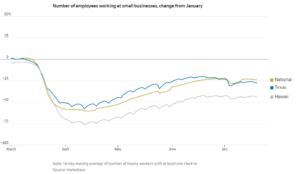Five months into the U.S. COVID-19 pandemic and rapid-onset recession, schools across much of Texas and the U.S. are opening to both on-campus and online education with social distancing and heightened cleaning procedures. As Americans began to resume more normal activity patterns in June and July, coronavirus cases surged, forcing a retreat to homes and numerous cancellations of fairs and other statewide and local celebrations. My kids’ school moved the start date up and then pushed it back. They started school this week with temperature checks and masks. I hope they can stay in school, not only because my two kiddos love being in school and learn well from their in-person teachers but because school is a lifeline to thousands of children who face hunger and abuse at home or in other care situations.
The economy has struggled to regain its footing. The latest BLS unemployment numbers show that claims rose last week after falling in past weeks, although there was also a slight uptick at the end of July. Unemployment claims have dropped substantially from April and May levels, but remain at 10.2 percent as of August 20, well above levels prior to the pandemic but below the May high of 17.1 percent. As of the August 20 jobs report, 14.8 million Americans remain unemployed (seasonally adjusted). The BLS reported today that 49 states reported job declines in the past year, and Texas ranks third in nonfarm job losses since July 2019, following California and New York; of course, those are also the most populous states, but Texas has shed 694,400 jobs. Idaho is the only state with stable job numbers.
A number of recent articles have reported effects on small businesses. The Wall Street Journal reported Texas Small Businesses experienced greater contractions in revenue and staffing as compared to the national average. Interestingly, Texas small businesses had performed better than the national average until the end of June.
Other recent articles have discussed the more severe effects on immigrant- and African American-owned businesses. A New York Federal Reserve report described changes in the number of active business owners by race and ethnicity relative to the nationwide decreased of 22%: black (-41%), Latino (-32%), Asian (-26%), and white (-17%). Not only were African American businesses more likely to be located in COVID-19 hotspots, weaker cash positions and banking relationships also hampered minority business survival.
This blog (and numerous other sources) have noted that lower skilled and lower income individuals and households experience the brunt of recession. Last week, the Washington Post observed that the recession is largely over for wealthy families as the stock market and home values have recovered, but working class families continue to struggle. Some economists refer to the diverging paths for wealthy and poor households as a K-shaped recovery.
Fed chairman Jerome Powell said back in May that an economic recovery could take more than a year, and that a vaccine would play an important role in that recovery. As we progress through the political party conventions into the election season, we will likely hear more about vaccines, supporting small businesses and unemployed workers, and fostering economic recovery.
